Perry Lake Bares All
Posted: Tuesday, January 16, 2001
By: Darren Schroeder
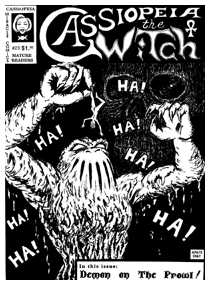
The Small Press Fan sent out his questions, and amongst those that replied was Perry Lake. He lives in Butte County, California and has been working in the area of Small Press for a number of years. He is the creator of Cassiopeia The Witch and was a one time paranormal investigator. We couldn't resist continuing what the Small Press Fan started, so here's an interview for you....
Small Press Fan: How long have you been interested in drawing and/or writing?
Perry Lake: The back of an old desk has an illo of Batman in green crayon that I did when I was about five years old. Although not actually writing, I started making up stories about monsters and superheroes at about the same time. I either play-acted them out with other children or I made up disturbingly complex stories about various toys.
SPF: Did you do well in art classes (or english for writers) while you were attending school?
PL: My last year of high school I had an art teacher who insisted I draw "by the rules" and never try anything new. I ended up not drawing anything for 12 years.
SPF: Were you encouraged to pursue your interest in art or writing by anyone when you were young?
PL: Not really. I usually heard something like, "that's nice," but never any real encouragement.
SPF: How old were you when you read your first comic book?
PL: I've been asked this before, and I have to say I honestly don't remember. It was probably something my Aunt Ina had laying around the house to keep children occupied, like Tarzan or some westerns based on tv series or something. My first superheroes were probably her copies of Superman, but then came the Batman tv show and then I went crazy for Captain America.
SPF: Were you a regular comic book reader as a child?
PL: I was probably an irregular comics fan. Remember, they didn't have comic specialty shops in those days. The place I could most regularly find comicbooks was in liquor stores next to Playboy magazine. (Hmm. Maybe that's why I have so many naked women in my comics....)
SPF: What non-comic book artforms were you exposed to as a child? (Museums, art history classes, books, films, etc.)
PL: All, especially monster movies. I would see a monster movie at night and the next day I would make the monsters in modelling clay and create sequels.
SPF: Who or what would you say have been the major influences on your art or writing?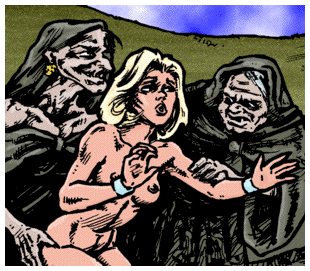 PL: Creepy, Eerie, (the original) Vampirella, and especially the Tomb of Dracula were my principal comic influences at an early age. I also liked the works of H.P. Lovecraft and J.R.R. Tolkien (who I think really tie-in surprisingly well) as well as Edgar Allan Poe and Robert E. Howard. But I don't know that I've ever consciously imitated any of these authors/works.
PL: Creepy, Eerie, (the original) Vampirella, and especially the Tomb of Dracula were my principal comic influences at an early age. I also liked the works of H.P. Lovecraft and J.R.R. Tolkien (who I think really tie-in surprisingly well) as well as Edgar Allan Poe and Robert E. Howard. But I don't know that I've ever consciously imitated any of these authors/works.
SPF: How did you first learn about small press?
PL: I heard about small pressers about four years before I ever drew a Cassie comic. They sounded like a bunch of losers to me.
SPF: What was your first "official" small press comic called?
PL: Cassiopeia the Witch #1. It was a 3-page experiment, just to see if I could do it. But I haven't been able to stop!
SPF: How many comics or publications would you say you have contributed to or published to date?
PL: 40 issues of Cassiopeia the Witch (with a couple skips). Three issues of Rawlins, the Last Tough Cop. Three funnybooks and a couple other comics. And a couple dozen articles back when I was a freelance reporter. I've also contributed various illos to other folks' comics and I've written scripts or contributed ideas to Fantasy Theater, Frank & Jolly, and others I can't recall. Professionally, I've had my work published (in collaboration with S.S. Crompton) in Demi the Demoness & Cassiopeia the Witch #1 (the sequel should come out next year) and Demi the Demoness #5 (though I only did 4 pages). I'm also in the Tales of Shaundra 2001 calendar (why was I given november?). Yowzers.com has used five or six of my designs and I've done some promotional art for Spalji Organics (an illo for their sensual powder line was my latest). There's a couple other projects waiting in the wings, but I'll believe it when I see 'em published.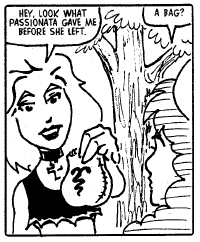 SPF: What is your fondest small press related memory?
SPF: What is your fondest small press related memory?
PL: More than the comics, it has been meeting and working with and just chatting with a bunch of really nice people.
SPF: Why do you create small press comics or publications?
PL: I believe it was Dumas who, when asked why he wrote, said, "why, to have something to read!"
SPF: What small press co-ops or clubs do you belong to?
PL: None.
SPF: What are your three favorite small press publications published by someone other than yourself?
PL: Fantasy Theater (although I'm not really a fan of superheroes) Tales of Fantasy, featuring Madame Boogala (possibly defunct because Larry hasn't put out an issue in a while) Reverend Ablack--because it scares me (definitely defunct after going fullsize for two issues)
SPF: What three "pro" comic books do you read regularly?
PL: I read Strangers in Paradise on an irregular basis. That and Demi the Demoness.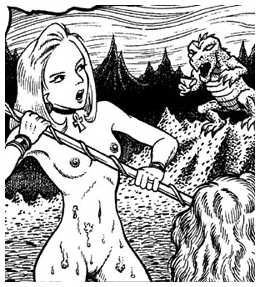 SPF: What is your work process when you create?
SPF: What is your work process when you create?
PL: Spurts and bounds, like most people who can't seem to make a go of it professionally. I come up with an idea (then I wash my hands), then I do an outline, write the script, scribble out a layout, pencil it, and try to find someone to ink it for me. I've started doing the lettering on the computer and it's best to paste it down after the pencilling, but before the inking.
SPF: How much time are you able to devote to small press activities in a week?
PL: Not as much as I would like. For the last several months I've done nothing, but now I'm hoping to get caught up on some more projects.
SPF: Where do you get your ideas or inspiration from?
PL: Everywhere. I have diarhea of the brain. I'm constantly spuing out ideas. Ask anyone in the small press.
SPF: What are your long time plans or goals that you wish to accomplish in small press?
PL: As Randy H. Crawford said, "all small press success stories involve getting out of the small press."
SPF: What are you working on now?
PL: In small press, Cassiopeia the Witch #39. Then I'm going to work on Cassiopeia the Witch #41. Then I hope to go back and finally do Cassiopeia the Witch #31. Professionally, I'm doing a marijuana t-shirt for Yowzers.com (and no, I don't imbibe.), and a commissioned portrait, and there's talk of a team-up between Cassie, Demi, and Shaundra.
DS: Describe your Cassiopeia the Witch series for us.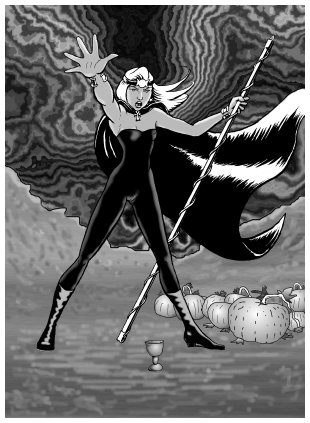 PL: I usually describe CTW as "monsters and naked women". And on a viseral level, that's true. Sex and the supernatural have long been big sellers, so I figured I would just combine the two. Cassiopeia is a modern, urban Wiccan practitioner. She lives in Berkeley, California where she works as a masseuse and occult bookstore clerk. She is a lesbian, vegetarian, and a nudist. For some strange reason, she seems to run into a lot of ghosts, demons, werewolves, mummies, sorcerers, devil-worshippers, giant snake monsters, and Born Again christians. So far, she seems to be taking it all in stride. I have 40 issues so far, although there are a couple of gaps in there. (CTW #31 and 39 have yet to see daylight, for different reasons.) There's also a Cassiopeia's Coven #1 (a #2 is not an impossibility), and Rawlins #1-3, in which Cassie has appeared. She's also been in other people's books occasionally, most notably, Demi The Demoness & Cassiopeia The Witch #1. A sequel should come out next year.
PL: I usually describe CTW as "monsters and naked women". And on a viseral level, that's true. Sex and the supernatural have long been big sellers, so I figured I would just combine the two. Cassiopeia is a modern, urban Wiccan practitioner. She lives in Berkeley, California where she works as a masseuse and occult bookstore clerk. She is a lesbian, vegetarian, and a nudist. For some strange reason, she seems to run into a lot of ghosts, demons, werewolves, mummies, sorcerers, devil-worshippers, giant snake monsters, and Born Again christians. So far, she seems to be taking it all in stride. I have 40 issues so far, although there are a couple of gaps in there. (CTW #31 and 39 have yet to see daylight, for different reasons.) There's also a Cassiopeia's Coven #1 (a #2 is not an impossibility), and Rawlins #1-3, in which Cassie has appeared. She's also been in other people's books occasionally, most notably, Demi The Demoness & Cassiopeia The Witch #1. A sequel should come out next year.
DS: Lots of sex-focused work relies on the sexual content to keep the audience interested and seems to ignore literate story telling. How do you think your work rates in that respect?"
PL: I'm a story guy. I've always believed stories are what make people read, not pretty pictures. That's not to say that art isn't extremely important in comic stories, but it must come second to the story. I've seen some adult comics with lots of wall-to-wall sex, and no story. I never pick them up. That stuff is even more boring than adult movies. The few comicbook eroticists (or pornographers, if you wish) that I know all want to tell stories. These stories just happen to have a lot of sex in them. Philo, who does the Shaundra books for Eros, recently told me that he'd rather do a hilarious comic about his Sword & Sorcery heroine and leave out the 12 pages of hardcore sex he's required to put in his book. Other artista have said the same thing. One of the reasons my sex scenes are so brief is that (usually) sex scenes slow down or even stop the story. Shaundra and Steve Crompton's Demi books are two of the few where the sex scenes are always pivotal to the storyline, no matter how ludicrous it might be.
I do think I've come to realize that the Adult market has as many or more restrictions than the standard comic market. I'd love to do an R-rated comic like the early Vampirella books, but that market no longer exists. So to be a success, I'm probably going to have to make Cassie start wearing some clothes. Sigh.
DS: Do readers send you bizzare suggestions for storylines/sexual high jinx?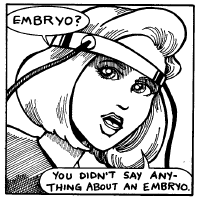 PL: As for sexual acts, I don't get very many suggestions from readers. A couple of guys have wanted to see Cassiopeia being raped. I quietly put those letters away and never look at them again. I get more legitimate storylines fairly regularly. Sometimes fellow creators have wanted to borrow Cassie for an appearance in their own books, such as J. Kevin Carrier's Ultra Squad epic or Steve Shipley's Graystown Girls. (And I've certainly asked that favor of other creators as well). One guy even asked (badgered?) me until I put his superhero character in my book, but I can't call that adventure a success.
PL: As for sexual acts, I don't get very many suggestions from readers. A couple of guys have wanted to see Cassiopeia being raped. I quietly put those letters away and never look at them again. I get more legitimate storylines fairly regularly. Sometimes fellow creators have wanted to borrow Cassie for an appearance in their own books, such as J. Kevin Carrier's Ultra Squad epic or Steve Shipley's Graystown Girls. (And I've certainly asked that favor of other creators as well). One guy even asked (badgered?) me until I put his superhero character in my book, but I can't call that adventure a success.
Of course, people also just bounce ideas off me. I appreciate that, because I am notorious for giving other creators story suggestions all the time. Why should I be the only one coming up with new ideas? Randall H. Crawford, who formerly did the terrific Nice Day Comics Newsletter, gave me the ideas for stories in CTW #32 and 40, which he later drew. Heck, unbidden, he went ahead and wrote the script for #40! Eric Robertson and Mark Bratton sort of collaborated in a simaler way for Cassiopeia Special #3. A couple other books got their start from somebody's letters, but most are based on things I learned about while I was involved in paranormal research or by doing crossovers with other people's supernatural comics characters.
DS: What sort of paranormal research did you take part in?
PL: I used to be part of a local paranormal research society in the late 80's. We researched UFO abductions and bigfoot sightings and such, and gossiped about devil-worshipping cults and this girl we knew who was a werewolf. All of which took place here in Butte County, California. Our biggest group effort was the actual on-site examination of a haunted house. This place compared with The Amityville Horror for physical phenomenon. We had psychics and seances and measurements and everything. My job was to be the objective one, taking notes and such. I eventually wrote an article about the whole thing for a local news magazine. It was quite an experience, and some of these events made their way into my early Cassiopeia stories, especially the stuff about the William Wanders character. (William is actually quite a bit younger than the guy he's based on.)
But Butte County doesn't have the kind of economic base to hold onto talented and interesting people, so various members of the group moved away and left me behind. So while I don't visit haunted houses anymore, I can still write about the supernatural via my comics.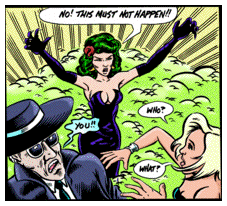 DS: Have faced any problems with censorship?
DS: Have faced any problems with censorship?
PL: I haven't had any real problems with censorship. One time one of the secretaries at work spied me collating my books at the office (on my own time, thank you), and she told the boss on me. He was cool about it, though. I gave him one of my books to see what it was really about and he admired it.
Of course, I understand Canada (and maybe New Zealand?) have much stricter mail standards than us in the US. The Canadian creators I've corresponded with all say they're amazed at what I can get away with. And compared to the big companies like Eros and Carnal, I'm pretty tame.
DS: I Don't know much about Canada's laws, but in New Zealand hardly anyone pays any attention to what local comic creators are up to. The occasional hardcore story makes an appearance, but as there are so few comic shops here no one has really tried to do much adult material. Our local shop has refused to stock a couple of New Zealand comics and doesn't handle any Eros or similar material apart from Heavy Metal. Customs and the censor used to ban the occasional comic in the past but I have not heared of any such rulings recently. When we hear about police raiding comic shops in the US we think things are stricter over there than here.
PL: Oh! THAT kind of censorship! I should explain that each of the 50 states have their own laws concerning censorship. In California, where I live, things are pretty lax. But in places like Oklahoma, Florida, or Texas, local law enforcement and crusading District Attorneys have been known to arrest comic book store owners and shut them down for selling adult comics to adults. No one could get away with that in California. For now, anyway. Also, those are comic stores selling bigtime comics. I sell my comics via the U.S. mail (and some day, the Internet), which doesn't really mess with adult material.
DS: What do your female friends think of your comics?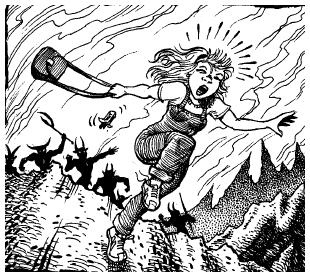 PL: Well, if I want to keep them as friends, I don't show them my comics! Seriously, I have quite a few female fans. Comics have always attracted a primarily male audience, but I think my percentage of women readers is pretty good. Certainly, I never have had any women readers who disliked Cassiopeia or the kinds of stories I do. On the other hand, two or three guys have as much as said that I have no right to do these kinds of comics. And you would recognize some of their names.
PL: Well, if I want to keep them as friends, I don't show them my comics! Seriously, I have quite a few female fans. Comics have always attracted a primarily male audience, but I think my percentage of women readers is pretty good. Certainly, I never have had any women readers who disliked Cassiopeia or the kinds of stories I do. On the other hand, two or three guys have as much as said that I have no right to do these kinds of comics. And you would recognize some of their names.
DS: What reasons have they given for their opposition?
PL: None. They just don't like it. My assumption is that they are prudes. Which, of course, they have every right to be.
DS: How big a role have office photocopiers played in your comic production?
PL: None. I always pay to get my comics printed at Mr. Kopy. The only thing I made use of at that office was the table space for collating pages. It's a lot easier than laying everything out on the living room floor.
DS: How do you define success? Is it getting paid, having a large audience or something else?
PL: Well, if you're not getting paid for the books you create, you're not a professional. That's a pretty basic definition. But that doesn't mean a creator can't find success in knowing he or she has put together a pretty darn good book. Getting people to like what you do, even if they are few in number, is a success. For me, I really enjoy doing these little digests and having fifty to a hundred people see them. But I also feel that I have something to say to a larger audience, and I won't be completely happy until I've made my little input into human society. The Demi crossover sold almost 2000 copies, so I know it's possible to reach
some people.
DS: You mentioned that "My last year of high school, I had an art teacher who insisted I draw "by the rules" and never try anything new. I ended up not drawing anything for 12 years." I can think of lots of friends who used to do lots of drawing at school who seem to just give up. Do art teacher do more harm than good in regards to drawing?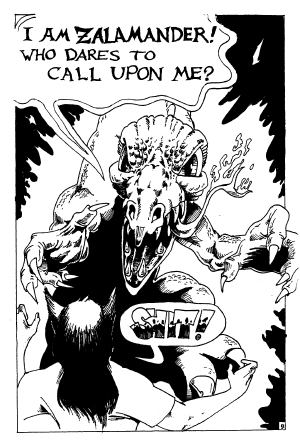 PL: Well, my last art teacher was pretty bad. She convinced me that the art world was looking for people who followed strict Rules of creativity, and that I would be judged only on how well I followed those Rules, not on the final product I created. I knew that was wrong, but I still thought she must represent the sort of thinking I would run into in the professional world. I was so disheartened, that I eventually gave up trying to do any kind of art. I did give me a chance to concentrate on my writing, though. However, the art teacher prior to that was great, and a lot of fun. He was totally unpretentious and let me try my hand at sculpting when everyone else was painting. So it's like anything else, some folks are good, some are bad.
PL: Well, my last art teacher was pretty bad. She convinced me that the art world was looking for people who followed strict Rules of creativity, and that I would be judged only on how well I followed those Rules, not on the final product I created. I knew that was wrong, but I still thought she must represent the sort of thinking I would run into in the professional world. I was so disheartened, that I eventually gave up trying to do any kind of art. I did give me a chance to concentrate on my writing, though. However, the art teacher prior to that was great, and a lot of fun. He was totally unpretentious and let me try my hand at sculpting when everyone else was painting. So it's like anything else, some folks are good, some are bad.
DS: What do you do for day job?
PL: I worked on Census 2000 this year, and they must have liked me because they made me a supervisor. And now I plan to continue with private-industry surveys, specifically, medical surveys. That job doesn't start until February, though. Until then, I draw designs for t-shirts, mousepads, coffee cups, and posters for various companies, mainly Yowzers.com run by my friend Barry Cunningham. The latest one will be The Computer From Hell mousepad, made to look like a fifties horror film poster. I'd really love to do something in publishing, like working for a small newspaper or magazine, but around here those publications are virtually nonexistant.
DS: Do comics make the world a better place?
PL: No, but they make it more fun. It's a terrific medium that still has a lot of potential. I only wish I had more hours in the day to read 'em and write 'em.
You can contact Perry Via:
Snail-Mail: 6167-B Alamo Way, Paradise, CA, 95969-4202.
E-mail: perrySTOP-@-SPAMCassieComics.com
www.CassieComics.com
Credits for the pictures above
Related links:
Crossover with Demi the Demoness
Crossover with Rawlins: The Last Tough Cop.
Cassiopeia, The Witch #37
Buy Perry's Products
If you have a comment or question about Small Press then feel free to contact me